ILSOYADVISOR POST
Evaluation of Nodulation
Illinois producers spend a lot of time developing a strong corn nitrogen program and implementing it throughout the growing season. We know that nitrogen is very important to a growing corn crop, but it’s just as important to a soybean plant. However, realistically, how much time is spent managing soybean’s nitrogen needs? There’s still an ongoing debate regarding how much nitrogen a corn plant needs, but it will likely fall between 0.9 to 1.2 units of nitrogen per bushel produced. However, a soybean plant can utilize upwards of 4.5 to 5.0 units of nitrogen per bushel produced. With this increased demand compared to corn, how come more focus isn’t on managing nitrogen for soybeans?

from a seed-applied inoculant.
Since a soybean plant is a legume, it can create a relationship between its root system and the bacteria living in the soil. This relationship results in nodules on the root system that when active (inside turns red), will supply plant-available nitrogen to the crop.
The nodules’ supply is directly related to the quantity and quality of active population living in the soil. The nodulation process will start around the V2-V3 growth stage. The quantity and quality of the nodulation can be impacted by crop rotation, drainage, tillage, pH, etc. Since nitrogen is important to soybean yields, it’s important to evaluate nodulation throughout the season: How many nodules are there? Where are they located on the root? What color is the inside? If low numbers are found, it’s time to start asking questions and looking for possible solutions.
There are currently several seed treatment options on the market that can provide supplementary support to boost the population in and around the root zone. However, not all products are created equal and one must ask the right questions to select the right product. For example: some products can be used as a dry powder in the seed box, and others are added as a seed coat. All these products are providing a different longevity of the bacteria that is being treated—bottom line, do your homework.

this means it’s actively working.
Regardless of your seed treatment selection, rotation, tillage and drainage system, it’s always important to stop and dig up soybean roots throughout the season to evaluate nodulation. Even if it’s later in the season and the nodules are no longer active, one can still find the growth on the roots for evaluation.





Comments
Add new comment